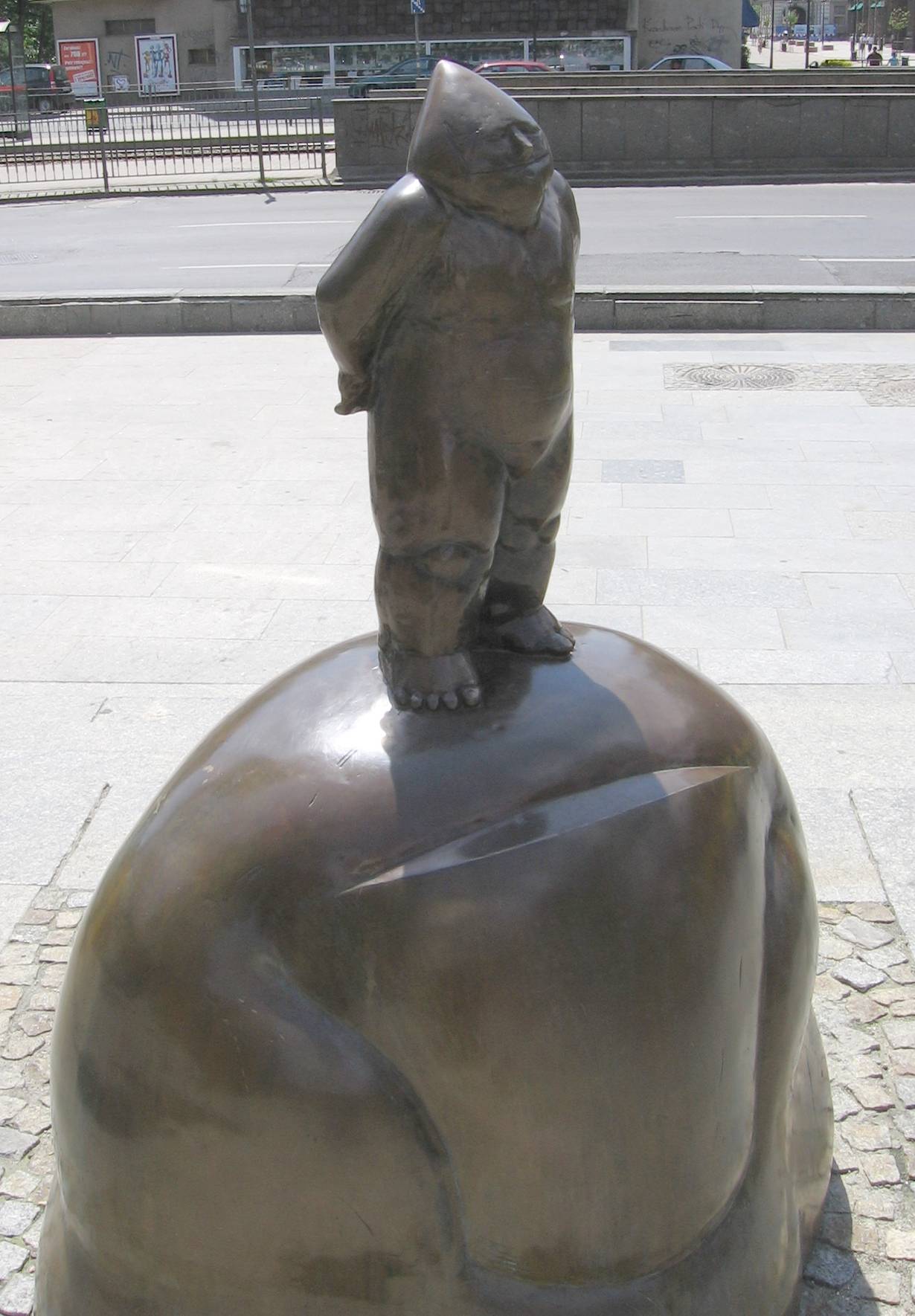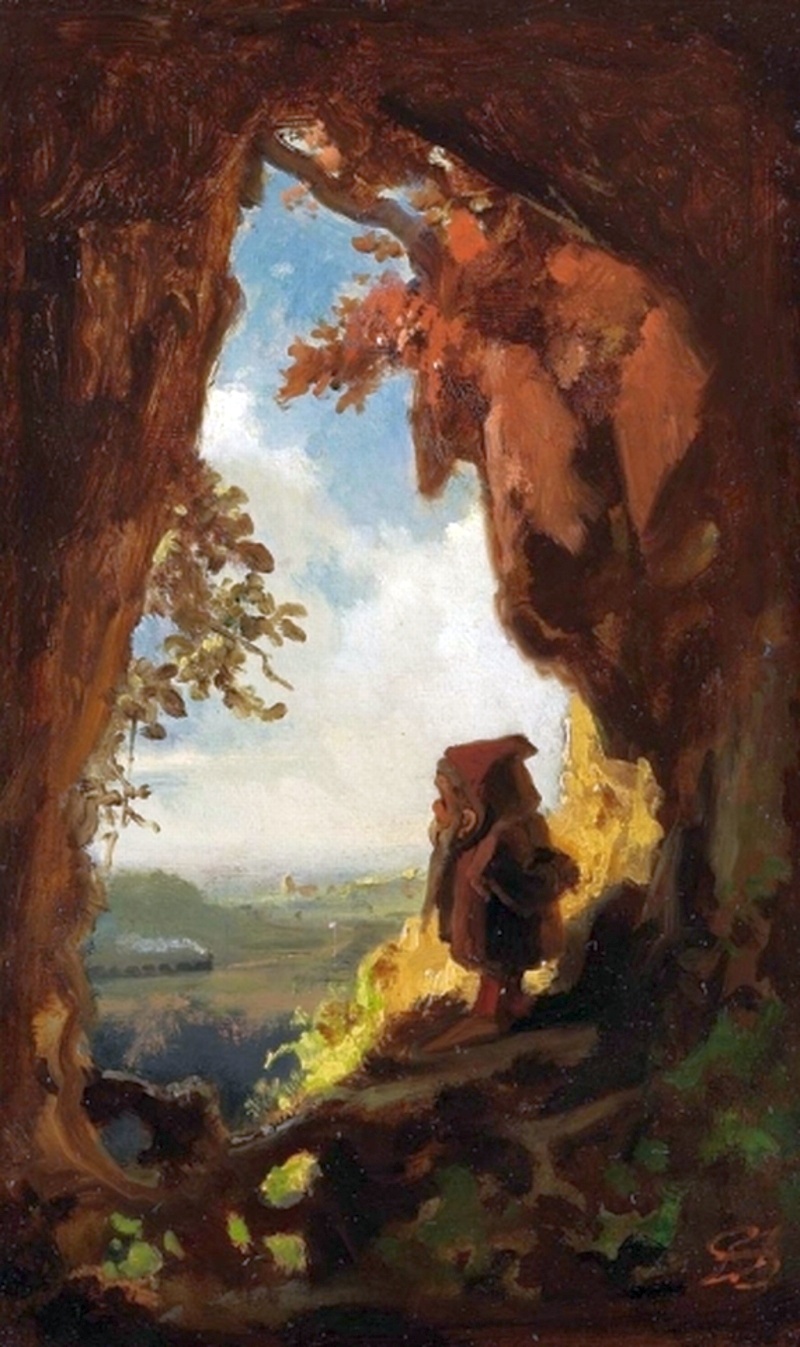|
Krasnoludek
Krasnoludek or krasnal is the Polish name for a mythological type of gnome or dwarf, common in many Polish and translated folk tales. They resemble small humans and wear pointy red hats. The mythological dwarf is of Germanic origin and appeared in Polish folktales in the 16th or 17th century. The word ''krasnoludek'' comes from the old Polish ''krasny, kraśny'' ("red, colorful," "nice-looking," or "good") and Polish ''ludek'' (small person or human-like creature). For example, the Brothers Grimm fairytale ''Snow White and the Seven Dwarfs'' is translated into the Polish language as ''Królewna Śnieżka i siedmiu krasnoludków''. Due to the popularization of fantasy literature, they are now differentiated from both gnomes (Polish: ''gnom'') and dwarfs (Polish: ''krasnolud''), both of which are used in fantasy literature context, while the word ''krasnoludek'' still remains mostly the domain of older folk tales. The word ''krasnal ogrodowy'' is also used to describe garden gn ... [...More Info...] [...Related Items...] OR: [Wikipedia] [Google] [Baidu] |
Dwarf (mythology)
A dwarf () is a type of supernatural being in Germanic folklore. Accounts of dwarfs vary significantly throughout history. They are commonly, but not exclusively, presented as living in mountains or stones and being skilled craftsmen. In early literary sources, only males are explicitly referred to as dwarfs. However, they are described as having sisters and daughters, while male and female dwarfs feature in later saga literature and folklore. Dwarfs are sometimes described as short; however, scholars have noted that this is neither explicit nor relevant to their roles in the earliest sources. Dwarfs continue to feature in modern popular culture, such as in the works of J. R. R. Tolkien and Terry Pratchett, where they are often, but not exclusively, presented as distinct from elves. Etymology and meaning Etymology The modern English noun ''dwarf'' descends from . It has a variety of cognates in other Germanic languages, including Old Norse ''dvergr'', Old Frisian ''dwerch'', ... [...More Info...] [...Related Items...] OR: [Wikipedia] [Google] [Baidu] |
Poland
Poland, officially the Republic of Poland, is a country in Central Europe. It extends from the Baltic Sea in the north to the Sudetes and Carpathian Mountains in the south, bordered by Lithuania and Russia to the northeast, Belarus and Ukraine to the east, Slovakia and the Czech Republic to the south, and Germany to the west. The territory has a varied landscape, diverse ecosystems, and a temperate climate. Poland is composed of Voivodeships of Poland, sixteen voivodeships and is the fifth most populous member state of the European Union (EU), with over 38 million people, and the List of European countries by area, fifth largest EU country by area, covering . The capital and List of cities and towns in Poland, largest city is Warsaw; other major cities include Kraków, Wrocław, Łódź, Poznań, and Gdańsk. Prehistory and protohistory of Poland, Prehistoric human activity on Polish soil dates to the Lower Paleolithic, with continuous settlement since the end of the Last Gla ... [...More Info...] [...Related Items...] OR: [Wikipedia] [Google] [Baidu] |
Gnome
A gnome () is a mythological creature and diminutive spirit in Renaissance magic and alchemy, introduced by Paracelsus in the 16th century and widely adopted by authors, including those of modern fantasy literature. They are typically depicted as small humanoids who live underground. Gnome characteristics are reinterpreted to suit various storytellers and artists. Paracelsus's gnome is recognized to have derived from the German miners' legend about or , the "metallurgical or mineralogical demon", according to Georg Agricola (1530), also called (literal Latinization of ''Bergmännlein'', "mountain manikin") by Agriocola in a later work (1549), and described by other names such as (sing. ; Latinization of German ). Agricola recorded that, according to the legends of that profession, these mining spirits acted as miming and laughing pranksters who sometimes threw pebbles at miners, but could also reward them by depositing a rich vein of silver ore. Paracelsus also called ... [...More Info...] [...Related Items...] OR: [Wikipedia] [Google] [Baidu] |
Folklore
Folklore is the body of expressive culture shared by a particular group of people, culture or subculture. This includes oral traditions such as Narrative, tales, myths, legends, proverbs, Poetry, poems, jokes, and other oral traditions. This also includes material culture, such as traditional building styles common to the group. Folklore also encompasses customary lore, taking actions for folk beliefs, including folk religion, and the forms and rituals of celebrations such as Christmas, weddings, folk dances, and Rite of passage, initiation rites. Each one of these, either singly or in combination, is considered a Cultural artifact, folklore artifact or Cultural expressions, traditional cultural expression. Just as essential as the form, folklore also encompasses the transmission of these artifacts from one region to another or from one generation to the next. Folklore is not something one can typically gain from a formal school curriculum or study in the fine arts. Instead, thes ... [...More Info...] [...Related Items...] OR: [Wikipedia] [Google] [Baidu] |
Polish Language
Polish (, , or simply , ) is a West Slavic languages, West Slavic language of the Lechitic languages, Lechitic subgroup, within the Indo-European languages, Indo-European language family, and is written in the Latin script. It is primarily spoken in Poland and serves as the official language of the country, as well as the language of the Polish diaspora around the world. In 2024, there were over 39.7 million Polish native speakers. It ranks as the sixth-most-spoken among languages of the European Union. Polish is subdivided into regional Dialects of Polish, dialects. It maintains strict T–V distinction pronouns, Honorifics (linguistics), honorifics, and various forms of formalities when addressing individuals. The traditional 32-letter Polish alphabet has nine additions (, , , , , , , , ) to the letters of the basic 26-letter Latin alphabet, while removing three (x, q, v). Those three letters are at times included in an extended 35-letter alphabet. The traditional set compri ... [...More Info...] [...Related Items...] OR: [Wikipedia] [Google] [Baidu] |
Brothers Grimm
The Brothers Grimm ( or ), Jacob Grimm, Jacob (1785–1863) and Wilhelm Grimm, Wilhelm (1786–1859), were Germans, German academics who together collected and published folklore. The brothers are among the best-known storytellers of Oral tradition, folktales, popularizing stories such as "Cinderella" ("), "The Frog Prince (story), The Frog Prince" (""), "Hansel and Gretel" ("), "Town Musicians of Bremen" (""), "Little Red Riding Hood" (""), "Rapunzel", "Rumpelstiltskin" (""), "Sleeping Beauty" (""), and "Snow White" (""). Their first collection of folktales, ''Grimms' Fairy Tales, Children's and Household Tales'' (), was first published in 1812. The Brothers Grimm spent their formative years in the town of Hanau in the Landgraviate of Hesse-Kassel. Their father's death in 1796 (when Jacob was 11 and Wilhelm 10) caused great poverty for the family and affected the brothers many years after. Both brothers attended the University of Marburg, where they developed a curiosity about ... [...More Info...] [...Related Items...] OR: [Wikipedia] [Google] [Baidu] |
Snow White
"Snow White" is a German fairy tale, first written down in the early 19th century. The Brothers Grimm published it in 1812 in the first edition of their collection ''Grimms' Fairy Tales'', numbered as Tale 53. The original title was ''Sneewittchen'', which is a partial translation from Low German. The modern spelling is ''Schneewittchen''. The Grimms completed their final revision of the story in 1854, which can be found in the 1857 version of ''Grimms' Fairy Tales''. The fairy tale features elements such as the magic mirror, the poisoned apple, the glass coffin, and the characters of the Evil Queen and the seven Dwarfs. The seven dwarfs were first given individual names in the 1912 Broadway play '' Snow White and the Seven Dwarfs'' and then given different names in Walt Disney's 1937 film '' Snow White and the Seven Dwarfs''. The Grimm story, which is commonly referred to as "Snow White", should not be confused with the story of " Snow-White and Rose-Red" (in German ""), ano ... [...More Info...] [...Related Items...] OR: [Wikipedia] [Google] [Baidu] |
Fantasy Literature
Fantasy literature is literature set in an imaginary universe, often but not always without any locations, events, or people from the real world. Magic, the supernatural and magical creatures are common in many of these imaginary worlds. Fantasy literature may be directed at both children and adults. Fantasy is considered a genre of speculative fiction and is distinguished from the genres of science fiction and horror by the absence of scientific or macabre themes, respectively, though these may overlap. Historically, most works of fantasy were in written form, but since the 1960s, a growing segment of the genre has taken the form of fantasy films, fantasy television programs, graphic novels, video games, music and art. Many fantasy novels originally written for children and adolescents also attract an adult audience. Examples include ''Alice's Adventures in Wonderland'', the ''Harry Potter'' series, ''The Chronicles of Narnia'', and '' The Hobbit''. History Beginnings ... [...More Info...] [...Related Items...] OR: [Wikipedia] [Google] [Baidu] |
Gnome
A gnome () is a mythological creature and diminutive spirit in Renaissance magic and alchemy, introduced by Paracelsus in the 16th century and widely adopted by authors, including those of modern fantasy literature. They are typically depicted as small humanoids who live underground. Gnome characteristics are reinterpreted to suit various storytellers and artists. Paracelsus's gnome is recognized to have derived from the German miners' legend about or , the "metallurgical or mineralogical demon", according to Georg Agricola (1530), also called (literal Latinization of ''Bergmännlein'', "mountain manikin") by Agriocola in a later work (1549), and described by other names such as (sing. ; Latinization of German ). Agricola recorded that, according to the legends of that profession, these mining spirits acted as miming and laughing pranksters who sometimes threw pebbles at miners, but could also reward them by depositing a rich vein of silver ore. Paracelsus also called ... [...More Info...] [...Related Items...] OR: [Wikipedia] [Google] [Baidu] |
Wrocław
Wrocław is a city in southwestern Poland, and the capital of the Lower Silesian Voivodeship. It is the largest city and historical capital of the region of Silesia. It lies on the banks of the Oder River in the Silesian Lowlands of Central Europe, roughly from the Sudetes, Sudeten Mountains to the north. In 2023, the official population of Wrocław was 674,132, making it the third-largest city in Poland. The population of the Wrocław metropolitan area is around 1.25 million. Wrocław is the historical capital of Silesia and Lower Silesia. The history of the city dates back over 1,000 years; at various times, it has been part of the Kingdom of Poland, the Kingdom of Bohemia, the Kingdom of Hungary, the Habsburg monarchy of Austria, the Kingdom of Prussia and German Reich, Germany, until it became again part of Poland in 1945 immediately after World War II. Wrocław is a College town, university city with a student population of over 130,000, making it one of the most yo ... [...More Info...] [...Related Items...] OR: [Wikipedia] [Google] [Baidu] |








